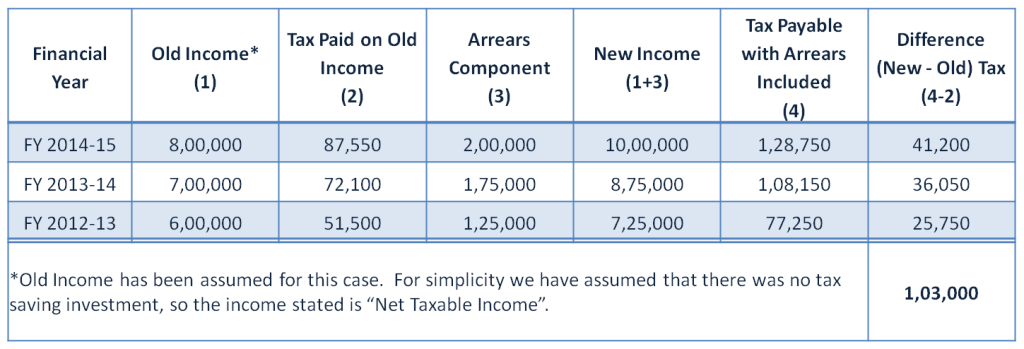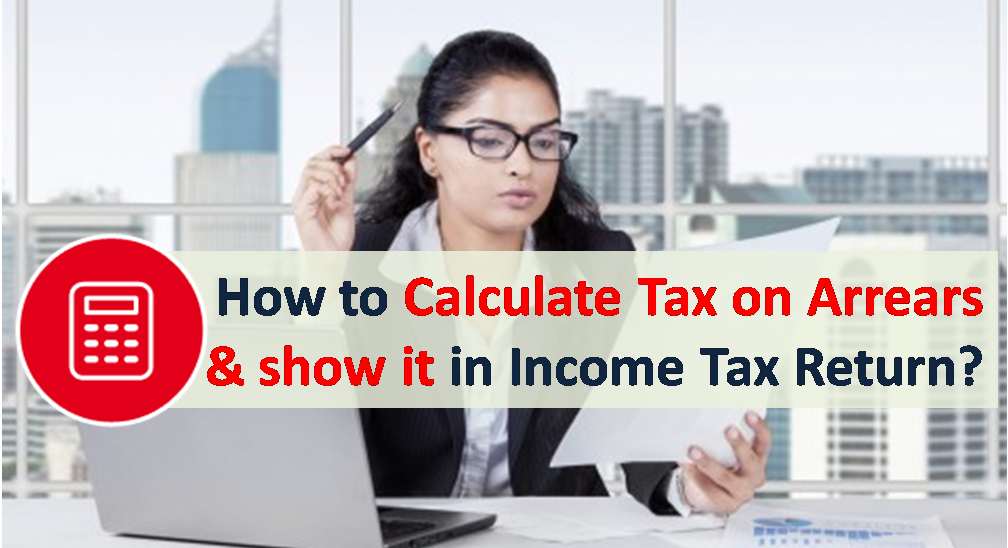This year might have been happy one for you if you received long pending salary dues as arrears. But we know receiving arrears makes everyone happy but pain of paying higher taxes makes them worried? We explain how to calculate tax on arrears and claim tax benefit u/s 89(1) in income tax return with example.
Tax Calculation on Arrears:
We take a simple example. Amit is a government employee and he has received his long awaited salary dues as arrears. Here are the numbers.
- Salary income for FY 2015-16: Rs 9,00,000
- Additional Arrears received: Rs 5,00,000
- Total income: 14,00,000
This arrears was due from last 3 financial years as follows:
- FY 2014-15: Rs 2,00,000
- FY 2013-14: Rs 1,75,000
- FY 2012-13: Rs 1,25,000
We use this example to illustrate tax calculation on arrears. For simplicity we would assume that Amit has not invested for any tax exemption, so his income stated above is “Net Taxable Income”.
Download:The ultimate ebook guide to Save Tax for FY 2018-19
Step 1:
Calculate tax for present year without considering arrears
So for FY 2015-16, the taxable income without arrears = Rs 9,00,000
Income Tax Payable = Rs 1,08,150
Step 2:
Calculate tax for present year after adding arrears payout
So for FY 2015-16, the taxable income without arrears = Rs 9,00,000 + Rs 4,00,000 = Rs 14,00,000
Income Tax Payable = Rs 2,52,350
Step 3:
Subtract income tax payable you get in step 2 from step 1
Additional tax due to arrears: Rs 2,52,350 – 1,08,150 = Rs 1,44,200
Also Read: Best Tax Saving Investments u/s 80C
Step 4:
Allocate the arrears components to the respective financial years. So in our case it’s as follows
FY 2014-15: Rs 2,00,000
FY 2013-14: Rs 1,75,000
FY 2012-13: Rs 1,25,000
Step 5:
Calculate new tax payable for each financial year where the component of arrears is present i.e. adding arrears to the old income in respective financial years.

Add the excess tax payable across the financial years due to arrears. In our case it comes out to be Rs 1,03,000. This means that had the salary payout been on time you would have paid this amount as tax.
Step 6:
Subtract the excess tax payable due to arrears in Step 3 from the additional tax payable in Step 5.
Tax Difference: Rs 1,44,200 – Rs 1,03,000 = Rs 41,200.
If you consider arrears payment as income for only present financial year, you would be paying Rs 41,200 extra as taxes, without any fault of yours. Government thankfully understands the situation and has provided relief for tax payers under Section 89(1).
Also Read: Submit Income Tax Proof to Employer – How, When and Why?
Step 7:
Calculate your final tax liability for FY 2015-16
So for FY 2015-16, the taxable income with arrears = Rs 9,00,000 + Rs 4,00,000 = Rs 14,00,000
Income Tax Payable = Rs 2,52,350
Tax Deduction u/s 89(1) on account of arrears = Rs 41,200
Net Tax payable = Rs 2,52,350 – 41,200 = Rs 211,150
To claim the above tax benefit u/s 89(1), you need to fill up Form 10E. From FY 2014-15 (assessment year 2015-16), the income tax department has made it mandatory to file Form 10E if you want to claim relief under section 89(1). The form can be filled online on the Income Tax Website.
The question is what would have happened if there was no excess or lower tax as in Step 6?
There would be no special treatment. You just calculate your tax after adding arrears and pay our taxes. Section 89(1) would not be applicable!

Form 10E: How to fill?
The Form 10E can be filled online from Income Tax website. Here are the steps:
- Login to Income Tax efiling website.
- After you have logged in, click on tab named ‘e-File’ and select ‘Prepare & Submit Online Form (Other than ITR)
- On the next screen, select Form 10E and the Assessment Year from the drop down.
- The Form 10E would be displayed with instructions and annexure. Fill the relevant details and submit.
In case you do not submit Form 10E to take advantage of Sec 89(1), you might receive notice from income tax department saying: The relief u/s 89 has not been allowed in your case, as the online form 10E has not been filed by you. The furnishing of Online form 10E is required as per sec.89 of the Income Tax Act
Tax Calculators:
You can download the income tax calculator for past financial years here. Use them to calculate your taxes for the respective years.

sir,
Is the ‘total income’ in form 10e means the income after all deductions including rebate?
Dear Amit, it appears to me that there can be some relief u/s 89 [1] if and only if the taxpayer moved from a lower tax bracket to a higher bracket during the arrears period, or, if the tax slabs were increased during that period [which actually means the same thing]. E.g. if he were always in the 20% bracket throughout that period, it does not make any difference whether he spreads the arrears over those years, or pays the tax in the year of receipt. Am I right, or am I missing something?
You are totally right. The idea was increased income may put people in higher than usual tax slab and penalize without any fault of theirs. Hence the concept of arrears tax benefit.
Fy 17-18 mei fy 17- 18 k 2 month ka arrear oct mei mila means cy arrear received in same cy and 2 py k arrears hai thn jo form 10 e mei total income without arrear usme form 16 wali total income jayegi ya is sal ka cy arrear add krke fill krenge and itr mei form 16 wali total income ayegi ya alag se cy arrear include krna h pls help me.
SIR / MADAM , I HAVE RECEIVED ARREAR FROM THE YEAR 2000 TO 2018 RS 415804/- INCOMETAX DEDUCTED BY THE DEPTT. RS 123600/- HOW CAN I REFUNED THIS AMOUNT . PLEASE HELP ME . ALL BILLS YEARWISE ARE AVAILABLE WITH ME . REPLY PLEASE WITH SUITABLE GUIDELINES
My uncle has received arrears for the Previous Years 2005-06, 2006-07, 2007-08, 2008-09, 2009-10 in the Financial Year-2017-18. So while filing form 10E I should put the Gross Taxable Incomes of the Previous Years or The Net Taxable Income after 80C deductions because he was having 80C deductions during all those previous years.
Another Question is the I should put the total income received by him during those previous years or the total income due to him during those previous years
Sir, I’m 24 years old, Female, Government Employee. for submitting tax return for 2018-19, my Total Gross Salary from March 2018 to Feb 2019 Rs.463397/- and arrears on salary of Rs.373430/-(already tax deducted of Rs.5771 on Rs.409050) which is credited at the month of June 2018. now how to calculate my taxable income on salary and arrears of Salary.plz reply immediately.
I am doing MS from Medical college getting stipend. in 2017-2018 i have received 10 lakhs including arear of 4.50000 for the year 2016-2017 for which no return filed. I thank you for the details provided for claiming rebate u/s 89 A.
I have paid tuition fee of Rs. 12500000 and 150,0000 during the financial year 2016-17 & 2017-18. Can I claim this amount u/s 80C
Can separate return be filed for both the years without claiming rebate u/s 89(1) which can give much more advantage though the arear was released in April, 2018
Sir, my question is when i m calculating tax without arrear then what should be this arrear amt. Whether it should be net off nps or including nps? When i am calculating tax on current fy, i m taking deduction of nps in 80c.
Plz reply
Sir, after filling 10e form, how can I fill itr 1 with my HB loan relief and 80D relief . because there is no head showing two reliefs in form 10e and if I show it in itr 1,it is not calculating correct and there is mismatch found out.
Sir, I have received arrears of pension for F. Y. 2015-16, 2016-17 in F. Y. 2017-18 along with exempt income of commuted pension for government employees, gpf, Gis ,. How the arrears of pension will be shown in form 10E.
Hi Amit,
I have two questions,
1. What should be the taxable income that i should show in my ITR after submitting form 10E?
2. While calculating taxes for Form 10E, should i include the Education Cess also in the taxes?
Relief U/s 89
Claimed the above in FY 2016-17 for Arrears of Salary received spreading from 2009-2015.
Now in 2017-18 Arrears of HRA received spreading from 2009-2015 (same period)
How do I calculate Relief U/s 89 ?
Follow the same process you did for claiming arrears for salary. It does not matter if its HRA or basic salary
Sir,
I benefited from standard deduction of Rs .5000 & 2000 in the previous financial years, for my income was below the prescribed ceiling. Now I received arrears for the previous years which will offset this benefit(standard deduction).so while filing form 10E for tax relief under section 89(1) whether I have to refund the said standard deduction received.
Standard deduction was not applicable in past few financial years! I think there is some error in understanding – could you please clarify
Sir,
sorry. It was standard rebate under section 87-A or so. Kindly replace standard deduction with the word rebate in my query.
I am government employee. I have received arrears for FY 2016-17 in FY 2017-18.
My problem is my arrears deduction count FY 2017-18. my 2017-18 deduction are 122000 kya me arrear ke sath hue deduction ko 2017-18 me count kar sakta hu
Dear Amit,
In FY 2017-18 teachers in Telangana State received arrears pertains to FY 2014-15.
But most of the teachers not filed their returns for FY 2014-15 / FY 2015-16 / FY 2016-17.
Now they wants to claim relief u/s 89(1).
Is it Mandatory to file Income Tax Returns for the previous years to claim relief u/s 89(1) and for submission 10E.
Thanks in advance.
Dear Amit,
Waiting for your reply
No its not mandatory to file previous year returns for claiming Tax relief on Arrears u/s 89(1). However you need to compulsorily fill Form 10E online.
Hello Sir,
Thanks for explaining Relief U/s 89 with example.
My query is – while calculating the relief, if the previous year Total Income has Arrears included for those year tax submission, for current year calculation, should the GTI be inclusive of arrears or excluding.! Hope my question is understood.
Thanks in advance for your help
GTI (gross total income) would be including arrears!